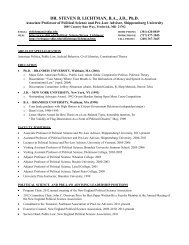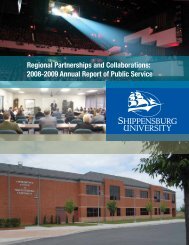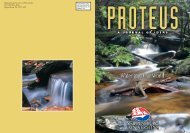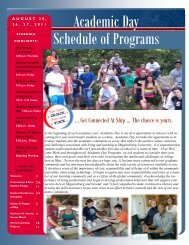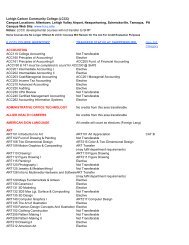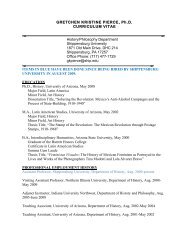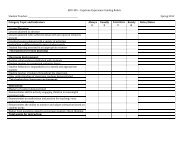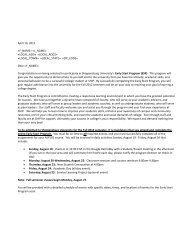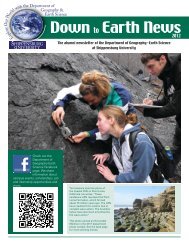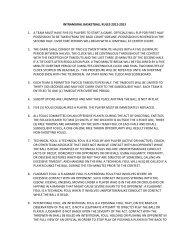Graduate Catalog - Shippensburg University
Graduate Catalog - Shippensburg University
Graduate Catalog - Shippensburg University
You also want an ePaper? Increase the reach of your titles
YUMPU automatically turns print PDFs into web optimized ePapers that Google loves.
<strong>University</strong> CurriculaCore AreasThe department has several core areas in which teaching andresearch activities are focused. While one goal of the program is toprovide broad training in environmental science, students will alignwith one or more faculty who will advise the student in course selectionand research. As such, students must make contact with facultymembers to determine where a student’s specific interests lie. Belowis a list of core areas:• Land Use/Human Geography• Techniques• Hydrology/Climatology• GeologyDeficiencies and PrerequisitesIf an incoming student has little or no experience with geographyor environmental science, s/he may be required to take undergraduatecourses (not for graduate credit) to overcome these deficiencies. Thedepartment chair, graduate coordinator, and curriculum committeewill establish a list of deficiencies (if any) for all students before theybegin the program. Courses from other higher education institutionsor appropriate professional experience may fulfill deficiencies.FacilitiesThe department has two 20-computer student labs that areequipped with the latest versions of GIS, image processing, wordprocessing, and data analysis software as well as color and black andwhite laser printers. In addition, there is a small research computerlab that is equipped with specialized software along with a 42 inchplotter for poster printing. Attached to the computer labs is a communalgraduate assistant office that also contains computers. <strong>Graduate</strong>students also have access to the student lounge located betweenthe GIS labs.The department owns numerous pieces of field equipment thatcan be used for classroom applications as well as student research.This equipment includes but is not limited to: digital surveyingequipment, hand held and logging hydrologic and meteorologicalequipment, soils and geologic tools, air quality monitoring equipment,maps, and GPS units. The software associated with much ofthis equipment is available in the student or research computer labs.There is dedicated lab space for processing any samples that arecollected for classroom or research field projects. Arrangements alsoexist for more sophisticated off-site sample processing. The universityis also part of the Marine Science Consortium at Wallops Island.Students may take advantage of this facility during their graduateprogram for classroom, research, and internship opportunities.Degree Requirements:Students are required to take at least 36 credits to complete themaster’s degree in Geoenvironmental Studies. Listed below are thespecific courses and requirements that must be completed to earn thedegree.• Students must take GEO503 Fundamentals of GeoenvironmentalResearch during the first semester it is offered.• Students must take a minimum of 18 credits at the 500 level,including GEO503.• Students may take a maximum of 12 credits at the 400 level forcredit towards the M.S. degree.• Students must take a minimum of 3 credits of geotechniquescourses at either the 400 or 500 levels.• Students may take a maximum of 6 credits outside of thedepartment.• Students must complete a thesis (6 credits) OR a one semesterresearch project (3 credits) and internship (6 credits).• Students must take and pass the departmental practical exam.REQUIRED COURSES:GEO503 Fundamentals of Geoenvironmental Studies (3 crs.,restricted to Geoenvironmental majors)A minimum of 3 credits of geotechniques chosen from thefollowing:GEO420 GIS III: Advanced Geographic Information SystemsGEO425 Image ProcessingGEO440 Field TechniquesGEO441 Quantitative MethodsGEO517 Applied GISGEO530 Mapping SciencesELECTIVES:ESS404 Applied Meteorology and ClimatologyESS413 Rock and Mineral ResourcesESS442 Environmental GeologyGEO402 Medical GeographyGEO404 Groundwater and HydrogeologyGEO415 Regional Geographic StudiesGEO420 GIS III: Advanced Geographic Information SystemsGEO425 Image ProcessingGEO440 Field TechniquesGEO441 Quantitative MethodsGEO444 Environmental Land Use PlanningGEO446 Water Resources ManagementGEO450 Geography-Geology Field Studies (1-3 crs.)GEO490 Selected Topics (1-3 crs.)GEO514 Urban EnvironmentGEO517 Applied GISGEO522 Geoenvironmental HydrologyGEO524 The Geologic EnvironmentGEO528 Geography of Economic and Environmental SystemsGEO530 Mapping SciencesGEO531 GeomorphologyGEO532 Disease and EnvironmentGEO536 Problems of the Atmospheric EnvironmentGEO542 Land Use RegulationsGEO546 Geoenvironmental Research IGEO548 Geoenvironmental Research IIGEO594 Selected Topics (1-3 crs.)GEO599 Independent StudyINTERNSHIP OR THESIS:Six credits of internship or thesis must be taken. If an internshipis taken, a 3 credit research course (GEO594 or GEO599) isrequired.GEO609 Internship IGEO610 Internship IIGEO612 Thesis IGEO613 Thesis IIStudents pursuing both a Master of Science in Geoenvironmental StudiesAND Teacher Certification in Geography-Social Studies or Earth-SpaceScience, may use EDU495 Student Teaching and Professional Practicum(6 credits) in place of GEO609 Internship I and GEO610 Internship II.NATURAL/SOCIAL SCIENCE ELECTIVES:Up to 6 credits may be taken from outside Geography-Earth Scienceby advisement.41



